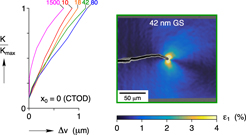Crossref Citations
This article has been cited by the following publications. This list is generated based on data provided by
Crossref.
Chen, Junyu
Yin, Hao
Kang, Guozheng
and
Sun, Qingping
2018.
Fatigue Crack Growth in Cold-Rolled and Annealed Polycrystalline Superelastic NiTi Alloys.
Acta Mechanica Solida Sinica,
Vol. 31,
Issue. 5,
p.
599.
Yu, Chao
Kang, Guozheng
Xie, Xi
and
Rao, Wei
2018.
A micromechanical model for the grain size dependent super-elasticity degeneration of NiTi shape memory alloys.
Mechanics of Materials,
Vol. 125,
Issue. ,
p.
35.
Wang, Bing
Kang, Guozheng
Kan, Qianhua
Wu, Wenping
Zhou, Kun
and
Yu, Chao
2018.
Atomistic study on the super-elasticity of nanocrystalline NiTi shape memory alloy subjected to a cyclic deformation.
Computational Materials Science,
Vol. 152,
Issue. ,
p.
85.
Paul, Partha P.
Fortman, Margaret
Paranjape, Harshad M.
Anderson, Peter M.
Stebner, Aaron P.
and
Brinson, L. Catherine
2018.
Influence of Structure and Microstructure on Deformation Localization and Crack Growth in NiTi Shape Memory Alloys.
Shape Memory and Superelasticity,
Vol. 4,
Issue. 2,
p.
285.
Chen, Z.
Lenthe, W.
Stinville, J. C.
Echlin, M.
Pollock, T. M.
and
Daly, S.
2018.
High-Resolution Deformation Mapping Across Large Fields of View Using Scanning Electron Microscopy and Digital Image Correlation.
Experimental Mechanics,
Vol. 58,
Issue. 9,
p.
1407.
Pelton, Alan R.
Pelton, Sean M.
Jörn, Tim
Ulmer, Jochen
Niedermaier, Dave
Plaskonka, Katrazyna
LePage, William S.
Saffari, Payman
and
Mitchell, M. R.
2019.
Fourth Symposium on Fatigue and Fracture of Metallic Medical Materials and Devices.
p.
1.
Wu, Y.
Yaacoub, J.
Brenne, F.
Abuzaid, W.
Canadinc, D.
and
Sehitoglu, H.
2019.
Deshielding effects on fatigue crack growth in shape memory alloys- A study on CuZnAl single-crystalline materials.
Acta Materialia,
Vol. 176,
Issue. ,
p.
155.
Ahadi, Aslan
Kawasaki, Takuro
Harjo, Stefanus
Ko, Won-Seok
Sun, QingPing
and
Tsuchiya, Koichi
2019.
Reversible elastocaloric effect at ultra-low temperatures in nanocrystalline shape memory alloys.
Acta Materialia,
Vol. 165,
Issue. ,
p.
109.
Belyaev, Sergey
Resnina, Natalia
Saveleva, Anastasia
Glazova, Diana
and
Pilyugin, Vitali
2019.
Influence of the grain size on the strain variation on cooling and heating of Ni50.2Ti49.8 alloy under stress.
Materials Science and Engineering: A,
Vol. 759,
Issue. ,
p.
778.
Dornelas Silva, Jéssica
and
Lopes Buono, Vicente Tadeu
2019.
Effect of the initial phase constitution in the low-cycle fatigue of NiTi wires.
SN Applied Sciences,
Vol. 1,
Issue. 12,
Montgomery, C.B.
Koohbor, B.
and
Sottos, N.R.
2019.
A Robust Patterning Technique for Electron Microscopy-Based Digital Image Correlation at Sub-Micron Resolutions.
Experimental Mechanics,
Vol. 59,
Issue. 7,
p.
1063.
Xu, Bo
Kang, Guozheng
Yu, Chao
and
Kan, Qianhua
2020.
Phase field simulation on the grain size dependent super-elasticity and shape memory effect of nanocrystalline NiTi shape memory alloys.
International Journal of Engineering Science,
Vol. 156,
Issue. ,
p.
103373.
Shayanfard, Pejman
Šittner, Petr
Heller, Luděk
and
Šandera, Pavel
2020.
Finite element analysis on the effect of martensitic transformation and plastic deformation on the stress concentration factor in a thin notched superelastic NiTi ribbon.
Functional Materials Letters,
Vol. 13,
Issue. 05,
p.
2051028.
Chen, Junyu
Yin, Hao
and
Sun, Qingping
2020.
Effects of grain size on fatigue crack growth behaviors of nanocrystalline superelastic NiTi shape memory alloys.
Acta Materialia,
Vol. 195,
Issue. ,
p.
141.
Panin, Sergey
Vlasov, Ilya
Maksimov, Pavel
Moiseenko, Dmitry
Maruschak, Pavlo
Yakovlev, Alexander
Schmauder, Siegfried
and
Berto, Filippo
2020.
Increasing Fatigue Life of 09Mn2Si Steel by Helical Rolling: Theoretical–Experimental Study on Governing Role of Grain Boundaries.
Materials,
Vol. 13,
Issue. 20,
p.
4531.
Yin, YuanJie
Xie, HuiMin
and
He, Wei
2020.
In situ SEM-DIC technique and its application to characterize the high-temperature fatigue crack closure effect.
Science China Technological Sciences,
Vol. 63,
Issue. 2,
p.
265.
Yang, Zhi-Wei
Li, Heng
Zhang, Yan-Hong
Liu, Xin
Wang, Xin-Hao
and
Gu, Qing-Fei
2020.
Microstructure evolution of Ni47Ti44Nb9 shape memory alloy in high-temperature deformation.
International Journal of Lightweight Materials and Manufacture,
Vol. 3,
Issue. 4,
p.
376.
Zhang, Wen
Simpson, Christopher A.
Lopez-Crespo, Pablo
Mokhtarishirazabad, Mehdi
Buslaps, Thomas
Pippan, Reinhard
and
Withers, Philip J.
2020.
The effect of grain size on the fatigue overload behaviour of nickel.
Materials & Design,
Vol. 189,
Issue. ,
p.
108526.
Senol, K.
Cao, H.
and
Tripathy, S.
2021.
Characterization and Validation of Fatigue Strains for Superelastic Nitinol Using Digital Image Correlation.
Journal of Medical Devices,
Vol. 15,
Issue. 4,
Velmurugan, C.
Senthilkumar, V.
Kesavan, J.
and
Ramya, K.
2021.
Effects of sintering temperature on grain growth of NiTiCu shape memory alloy.
Materials Today: Proceedings,
Vol. 39,
Issue. ,
p.
1570.




